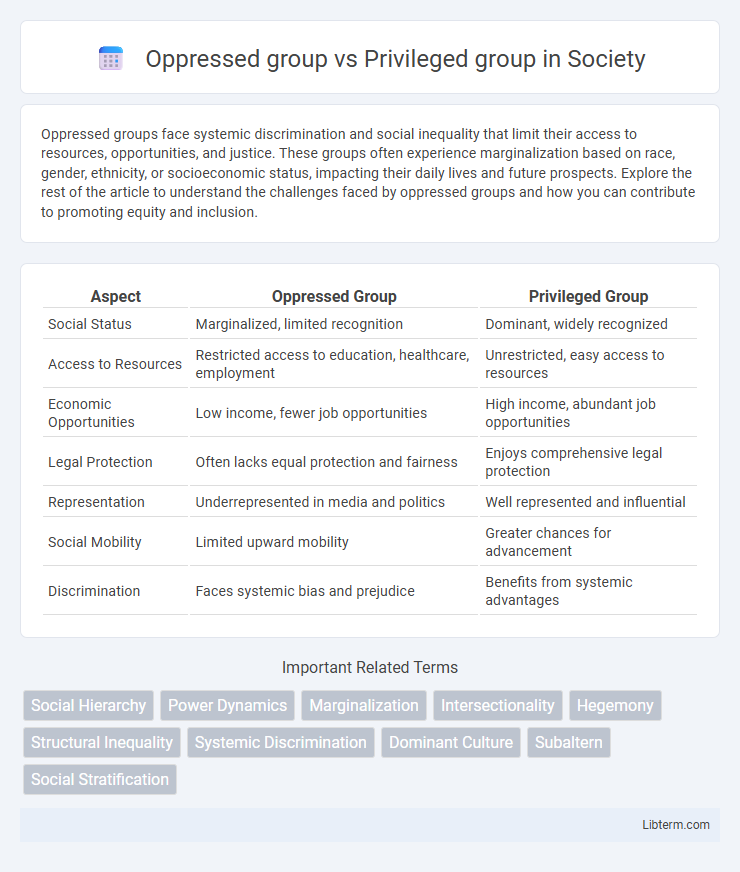Oppressed groups face systemic discrimination and social inequality that limit their access to resources, opportunities, and justice. These groups often experience marginalization based on race, gender, ethnicity, or socioeconomic status, impacting their daily lives and future prospects. Explore the rest of the article to understand the challenges faced by oppressed groups and how you can contribute to promoting equity and inclusion.
Table of Comparison
| Aspect | Oppressed Group | Privileged Group |
|---|---|---|
| Social Status | Marginalized, limited recognition | Dominant, widely recognized |
| Access to Resources | Restricted access to education, healthcare, employment | Unrestricted, easy access to resources |
| Economic Opportunities | Low income, fewer job opportunities | High income, abundant job opportunities |
| Legal Protection | Often lacks equal protection and fairness | Enjoys comprehensive legal protection |
| Representation | Underrepresented in media and politics | Well represented and influential |
| Social Mobility | Limited upward mobility | Greater chances for advancement |
| Discrimination | Faces systemic bias and prejudice | Benefits from systemic advantages |
Defining Oppressed and Privileged Groups
Oppressed groups experience systemic disadvantages and barriers based on attributes like race, gender, or socioeconomic status, leading to unequal access to resources and opportunities. Privileged groups benefit from societal structures that grant them unearned advantages and social power, often remaining unaware of these benefits due to normalized dominance. Understanding the dynamics between oppressed and privileged groups highlights the importance of addressing structural inequalities and promoting social justice.
Historical Contexts of Power Dynamics
Historical contexts reveal that oppressed groups have often experienced systemic exclusion, disenfranchisement, and cultural marginalization, shaped by colonialism, slavery, and discriminatory laws. Privileged groups typically maintained economic, political, and social power through institutionalized dominance and control over resources, lawmaking, and cultural narratives. These entrenched power dynamics continue to influence social hierarchies and access to opportunities in contemporary societies.
Systemic Inequality: How It Persists
Systemic inequality persists as oppressed groups face barriers embedded in laws, policies, and institutional practices that limit access to education, employment, and healthcare compared to privileged groups. Historical discrimination and unequal resource distribution reinforce disparities, creating cycles of poverty and marginalization. Data shows that wealth gaps, incarceration rates, and educational attainment consistently favor privileged groups, perpetuating social and economic disadvantages for the oppressed.
Social Identity and Intersectionality
Oppressed groups experience systemic disadvantages and marginalization based on social identities such as race, gender, class, and sexuality, while privileged groups benefit from social, economic, and political advantages embedded in societal structures. Intersectionality reveals how overlapping identities intensify discrimination or privilege, highlighting the complexity of experiences within oppressed groups. Understanding social identity frameworks is essential for analyzing power dynamics and promoting equity in multicultural and diverse societies.
Manifestations of Privilege in Daily Life
Manifestations of privilege in daily life include unequal access to quality education, healthcare, and professional opportunities, often unnoticed by those benefiting from them. Privileged groups experience societal advantages such as representation in media, decision-making roles, and social networks, which reinforce systemic inequalities. These disparities contribute to ongoing power imbalances and limit social mobility for oppressed groups.
The Psychological Impact of Oppression
Oppression inflicts profound psychological distress on marginalized groups, leading to increased rates of anxiety, depression, and diminished self-esteem due to systemic discrimination and social exclusion. Privileged groups often remain unaware of this mental health burden, benefiting from unearned social advantages that buffer against such stressors. Understanding the psychological impact of oppression is crucial for developing inclusive mental health interventions and social policies.
Microaggressions and Everyday Bias
Oppressed groups frequently experience microaggressions, subtle verbal or behavioral slights that reinforce negative stereotypes and perpetuate systemic inequality. These everyday biases create an environment where marginalized individuals face continuous, low-level discrimination that impacts mental health and social inclusion. Privileged groups often remain unaware of these microaggressions, inadvertently sustaining power imbalances and limiting efforts toward equity and social justice.
Challenging Systems of Privilege
Oppressed groups confront systemic barriers entrenched in social, economic, and political institutions, limiting access to opportunities and resources compared to privileged groups who benefit from unearned advantages. Challenging systems of privilege involves dismantling institutionalized discrimination through advocacy, policy reform, and amplifying marginalized voices to promote equity. Effective strategies include intersectional approaches addressing race, gender, class, and other dimensions of inequality to create inclusive and just societies.
Allyship and Advocacy Strategies
Allyship involves actively supporting oppressed groups by amplifying their voices and addressing systemic inequalities, while advocacy strategies focus on policy change, education, and resource allocation to dismantle privilege and promote equity. Effective allyship requires recognizing one's own privilege and leveraging it to challenge discriminatory practices without overshadowing marginalized experiences. Strategic advocacy combines community organizing, legislative reform, and public awareness campaigns to create sustainable social change for oppressed populations.
Towards Equity: Building Inclusive Communities
Oppressed groups face systemic barriers and limited access to resources, while privileged groups often benefit from societal advantages historically rooted in power structures. Building inclusive communities requires recognizing these disparities, actively dismantling systemic inequities, and promoting equitable opportunities for all individuals. Implementing policies that address discrimination, increase representation, and foster cultural competency enhances social cohesion and moves societies closer to true equity.
Oppressed group Infographic

 libterm.com
libterm.com